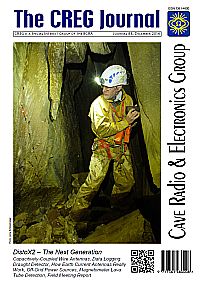
- The most recent issue to be published was 132
- For further information, please see Publishing/Despatch Schedule
- Database last updated on Mon, 01 Dec 2025 18:30:34 +0000
- Online access is currently available for all issues. Some of
the older issues are bit-map scans rather than digital copies.
journal scans.
- Online voting for CREG articles was withdrawn in June 2022. For info see
Voting for CREG articles
Contents of journal 88
December 2014
This page may take a few
seconds to load. Please wait ...
- CREG Journal 88 (0-24)
(PDF 11.6MB)
  Individual articles may be available below Individual articles may be available below
- This issue has a cover date of December 2014 and was published on 1 December 2014.
-
- Front Cover (1)
(PDF 1.3MB)

- Beat Heeb using the DistoX2 in the lower parts of the Säntishöhle, a 1200m long cave in north-east Switzerland. Photo: Jonny Schönenberger
-
- Contents (2)
(PDF 240KB)

- List of contents and masthead information.
-
- Capacitively-Coupled Wire Antennas for Cave Radios (3-4)
(PDF 632KB)

- Capacitively-coupled wire antennas have several advantages over grounded dipoles, asserts Graham Naylor. Here he outlines the principle and describes the benefits on offer.
-
- The Next Generation of the DistoX Cave Surveying Instrument (5-8)
(PDF 957KB)

- The DistoX2 is a new version of the popular DistoX cave surveying device. Like the original, it includes a laser distance meter, a 3-axis electronic compass/clinometer, and a wireless Bluetooth connection. As before, its construction is based on a commercially available laser distance meter. However, the integration of the extension board is quite different. As Beat Heeb describes, the new board replaces part of the Disto hardware and allows use of a rechargeable LiPo battery to improve compass precision.
-
- Letters (8)
(PDF 522KB)

- Radiolocation Depth Calculator.
-
- Web Watch (8) For download see previous item
- Just a few links from Peter Ludwig this time around.
-
- We Hear (9)
(PDF 320KB)

- News and events - Mike Bedford brings us the latest to impact the world of cave radio and electronics, including Mesh Network for Search and Rescue, The Electric Caving Suit, Charging Gets Faster, Desktop Carving Machine.
-
- Lava Tube Detection Using a Wireless Magnetometer (10-12)
(PDF 1.4MB)

- Using an Avnet Wi-Go wireless data acquisition system, Andy Lillington conducted further detection trials in Iceland. An Android smartphone was used to record data. Despite a well-developed methodology, results were mixed and further investigation and development may be necessary.
-
- How Earth-Current Antennas Really Work (13-14)
(PDF 265KB)

- With cave radio equipment, there has been a trend away from the use of induction loop antennas to the use of so-called earth-current antennas, i.e. long wires grounded at both ends. Both the HeyPhone and Nicola system use this type of antenna. However, the popular explanation for how this antenna works is fallacious. The antenna does not operate by allowing the current to flow in a 'big loop' in the ground, nor is it a 'conduction mode' of operation. In fact, it does not depend, fundamentally, on current flow in the ground at all. The fact that the popular explanation is wrong is important because, if we do not understand how the antenna works, it is difficult to know the best way to use it, nor how to design a better one. In this short note, David Gibson outlines a more useful model - that of the Grounded Horizontal Electric Dipole - but without the mathematical justification, which will be given in a future article. (Also see CREG forum).
-
- Power Supplies for 'Off-Grid' Operation (15-18)
(PDF 1.5MB)

- Mike Bedford reviews several power sources that are able to provide power for caving lamps, smartphones, tablets, laptops, cave radios, and other electronic equipment when there is no access to mains power.
-
- A Data Logging Draught Detector (19-21)
(PDF 747KB)

- The presence of a caver is liable to affect measurements made with sensitive draught detectors. Chris Hunter has coupled a thermistor-based detector to a data logger to allow monitoring in the absence of a caver. Longer-term monitoring is able to capture draughts that are dependent on changing environmental conditions.
-
- CREG Field Meeting: Autumn 2014 (22-24)
(PDF 5.8MB)

- A CREG field meeting in the Yorkshire Dales featured a wide range of activities and demonstrations. Mike Bedford reports.
-
- The Adventures of GREG (24)
(PDF 2.2MB)

- Illustrations by Adrian Higgins with words by Mike Bedford.
-

|

View Contents:

BCRA is a UK registered charity and is a constituent body of
the British Caving Association,
undertaking charitable activities on behalf of the BCA.
BCRA publishes a range of periodicals and books.
Click here for further information.
|
Searching
To Search our pages using Google, type a search
string in the box at the top of the page and hit your Return key
You can also search our publications catalogue at the British Caving Library
The CREG Journal Search Engine is a new, powerful search engine which will, sometime, be extended
to cover Cave & Karst Science. We have a keyword search facility on our Cave Science Indexes pages but this may be rather out-of-date.
|
For staff use: Link to Database
Show/Hide
download figures next to each item (if available and non-zero; you might need to refresh page first). Counters last
reset on Thu 03-Jan-2019 17:29:28 +00:00. The figures are non-unique
click-throughs.
|









